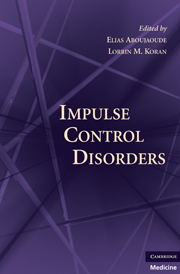Book contents
- Impulse Control Disorders
- Impulse Control Disorders
- Copyright page
- Dedication
- Contents
- Contributors
- Acknowledgments
- Introduction
- Section I Acquisitive Impulses
- Section II Pellicular Impulses
- Section III Information-Seeking Impulses
- Section IV Sexual and Aggressive Impulses
- 18 Hypersexuality: Clinical Aspects
- 19 The Sex Industry: Public Vice, Hidden Victims
- 20 Intermittent Explosive Disorder: Clinical Aspects
- 21 Violence against Women: Preventing a Social Scourge
- 22 Intimate Partner Violence: Aggression at Close Quarters
- 23 Pyromania: Clinical Aspects
- 24 Arson: Choking off the Flames
- Appendix I: Treatment Guidelines
- Appendix II: List of Scales and Assessment Instruments
- Index
20 - Intermittent Explosive Disorder: Clinical Aspects
from Section IV - Sexual and Aggressive Impulses
Published online by Cambridge University Press: 06 July 2010
- Impulse Control Disorders
- Impulse Control Disorders
- Copyright page
- Dedication
- Contents
- Contributors
- Acknowledgments
- Introduction
- Section I Acquisitive Impulses
- Section II Pellicular Impulses
- Section III Information-Seeking Impulses
- Section IV Sexual and Aggressive Impulses
- 18 Hypersexuality: Clinical Aspects
- 19 The Sex Industry: Public Vice, Hidden Victims
- 20 Intermittent Explosive Disorder: Clinical Aspects
- 21 Violence against Women: Preventing a Social Scourge
- 22 Intimate Partner Violence: Aggression at Close Quarters
- 23 Pyromania: Clinical Aspects
- 24 Arson: Choking off the Flames
- Appendix I: Treatment Guidelines
- Appendix II: List of Scales and Assessment Instruments
- Index
Summary
Keywords
- Type
- Chapter
- Information
- Impulse Control Disorders , pp. 221 - 232Publisher: Cambridge University PressPrint publication year: 2010
- 4
- Cited by



